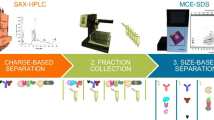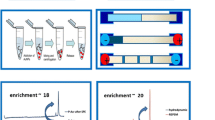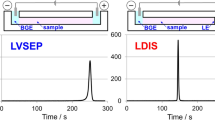Abstract
This paper demonstrated simultaneous separation of acidic and basic proteins using cationic gemini surfactants as buffer additives in capillary electrophoresis. We showed that even at a low concentration (0.1 mmol·L−1) of alkanediyl-α,ω-bis(dimethyloctadecylammonium bromide) (18-s-18), the wall adsorption of both acidic and basic proteins could be effectively suppressed under acidic conditions. Smaller micelle size (e.g., s = 5–8) is more effective for the separation of acidic proteins than larger micelle size (e.g., s < 4 or > 10). Varying the spacer length of gemini surfactants can influence the electrophoretic mobility and selectivity of proteins to achieve the desired separation. Under the optimized conditions, RSDs of the migration time were less than 0.8% and 2.2% for run-to-run and day-to-day assays, respectively, and protein recoveries ranged from 79% to 100.4%. Furthermore, we also investigated the use of gemini surfactant-capped gold nanoparticles (gemini@AuNPs) as buffer additives in protein separation. Introduction of AuNPs into the buffer shortened the analysis time and slightly improved the separation efficiencies. Finally, we presented the applications of this method in the analysis of biological samples, including plasma, red blood cells and egg white.
Similar content being viewed by others
References
Norde W, Haynes C A. Proteins at Interfaces II: Fundamentals and Applications. Washington DC: American Chemical Society, 1995
McCormick R M. Capillary zone electrophoretic separation of peptides and proteins using low pH buffers in modified silica capillaries. Anal Chem, 1988, 60: 2322–2328
Green J S, Jorgenson J W. Minimizing adsorption of proteins on fused silica in capillary zone electrophoresis by the addition of alkali metal salts to the buffers. J Chromatogr, 1989, 478: 63–70
Zhang H, Li X F, Le X C. Tunable aptamer capillary electrophoresis and its application to protein analysis. J Am Chem Soc, 2008, 130: 34–35
Tseng W L, Lin Y W, Chang H T. Improved separation of microhet-erogeneities and isoforms of proteins by capillary electrophoresis using segmental filling with SDS and PEO in the background electrolyte. Anal Chem, 2002, 74: 4828–4834
Gilges M, Kleemiss M H, Schomburg G. Capillary zone electrophoresis separations of basic and acidic proteins using poly(vinyl alcohol) coatings in fused silica capillaries. Anal Chem, 1994, 66: 2038–2046
Lu J J, Liu S, Pu Q. Replaceable cross-linked polyacrylamide for high performance separation of proteins. J Proteome Res, 2005, 4: 1012–1016
Sanzgiri R D, McKinnon T A, Cooper B T. Intrinsic charge ladders of a monoclonal antibody in hydroxypropylcellulose-coated capillaries. Analyst, 2006, 131: 1034–1043
Spanila M, Pazourek J, Havel J. Electroosmotic flow changes due to interactions of background electrolyte counter-ions with polyethyle-neimine coating in capillary zone electrophoresis of proteins. J Sep Sci, 2006, 29: 2234–2240
Yu C J, Tseng W L. Online concentration and separation of basic proteins using a cationic polyelectrolyte in the presence of reversed electroosmotic flow. Electrophoresis, 2006, 27: 3569–3577
Chiu R W, Jimenez J C, Monnig C A. High molecular weight polyar-ginine as a capillary coating for separation of cationic proteins by cap-illary electrophoresis. Anal Chim Acta, 1995, 307: 193–201
Huang X J, Wang Q Q, Huang B L. Preparation and evaluation of stable coating for capillary electrophoresis using coupled chitosan as coated modifier. Talanta, 2006, 69: 463–468
Lin C Y, Yu C J, Chen Y M, Chang H C, Tseng W L. Simultaneous separation of anionic and cationic proteins by capillary electrophoresis using high concentration of poly(diallyldimethylammonium chloride) as an additive. J Chromatogr A, 2007, 1165: 219–225
Cifuentes A, Rodriguez M A, Garcia-Montelongo F J. Separation of basic proteins in free solution capillary electrophoresis: Effect of addi-tive, temperature and voltage. J Chromatogr A, 1996, 742: 257–266
Strege M A, Lagu A L. Micellar electrokinetic capillary chromatography of proteins. Anal Biochem, 1993, 210: 402–410
Liu Q, Yang Y, Huang Y, Pan C, Nie Z, Yao S. Separation of acidic and basic proteins by capillary electrophoresis with CTAB additive and its applications in peptide and protein profiling. Electrophoresis, in press
Melanson J E, Baryla N E, Lucy C A. Double-chained surfactants for semipermanent wall coatings in capillary electrophoresis. Anal Chem, 2000, 72: 4110–4114
Towns J K, Regnier F E. Capillary electrophoretic separations of proteins using nonionic surfactant coatings. Anal Chem, 1991, 63: 1126–1132
Baryla N E, Lucy C A. Simultaneous separation of cationic and anionic proteins using zwitterionic surfactants in capillary electrophoresis. Anal Chem, 2000, 72: 2280–2284
Emmer A, Roeraade J. Wall deactivation with fluorosurfactants for capillary electrophoretic analysis of biomolecules. Electrophoresis, 2001, 22: 660–665
Wang C, Lucy C A. Oligomerized phospholipid bilayers as semipermanent coatings in capillary electrophoresis. Anal Chem, 2005, 77: 2015–2021
Gulcev M D, Lucy C A. Factors affecting the behavior and effective-ness of phospholipid bilayer coatings for capillary electrophoretic separations of basic proteins. Anal Chem, 2008, 80: 1806–1812
Menger F M, Keiper J S. Gemini surfactants. Angew Chem Int Ed, 2000, 39: 1906–1920
Zana R. Dimeric and oligomeric surfactants. Behavior at interfaces and in aqueous solution: A review. Adv Colloid Interface Sci, 2002, 97: 203–251
Zana R. Dimeric (gemini) surfactants: Effect of the spacer group on the association behavior in aqueous solution. J Colloid Interface Sci, 2002, 248: 203–220
Liu Q, Li Y, Tang F, Ding L, Yao S. Cationic gemini surfactant as dynamic coating in CE for the control of EOF and wall adsorption. Electrophoresis, 2007, 28: 2275–2282
Liu Q, Yuan J, Li Y, Yao S. Long-chained gemini surfactants for semipermanent wall coatings in capillary electrophoresis of proteins. Electrophoresis, 2008, 29: 871–879
Liu Q, Guo M, Nie Z, Yuan J, Tan J, Yao S. Spacer-mediated synthesis of size-controlled gold nanoparticles using geminis as ligands. Langmuir, 2008, 24: 1595–1599
Pumera M, Wang J, Grushka E, Polsky R. Gold nanoparticle-enhanced microchip capillary electrophoresis. Anal Chem, 2001, 73: 5625–5628
Huang M F, Kuo Y C, Huang C C, Chang H T. Separation of long double-stranded DNA by nanoparticle-filled capillary electrophoresis. Anal Chem, 2004, 76: 192–196
Yu C J, Su C L, Tseng W L. Separation of acidic and basic proteins by nanoparticle-filled capillary electrophoresis. Anal Chem, 2006, 78: 8004–8010
Zana R, Benrraou M, Rueff R. Al-kanediyl-α,ω-bis (dimethylalk-ylammonium bromide) surfactants. 1. Effect of the spacer chain length on the critical micelle concentration and micelle ionization degree. Langmuir, 1991, 7: 1072–1075
Gas B, Kenndler E. System zones in capillary zone electrophoresis. Electrophoresis, 2004, 25: 3901–3912
Melanson J E, Baryla N E, Lucy C A. Dynamic capillary coatings for electroosmotic flow control in capillary electrophoresis. Trends Anal Chem, 2001, 20: 365–374
Lucy C A, MacDonald A M, Gulcev M D. Non-covalent capillary coatings for protein separations in capillary electrophoresis. J Chromatogr A, 2008, 1184: 81–105
Zana R. Alkanediyl-α,ω-bis(dimethylalkylammonium bromide) surfactants 10. Behavior in aqueous solution at concentrations below the critical micellization concentration: An electrical conductivity study. J Colloid Interface Sci, 2002, 246: 182–190
Atkin R, Craig V S J, Wanless E J, Biggs S. Adsorption of 12-s-12 gemini surfactants at the silica-aqueous solution interface. J Phys Chem B, 2003, 107: 2978–2685
Danino D, Talmon Y, Zana R. Al-kanediyl-α,ω-bis (dimethylal-kylammonium bromide) surfactants (dimeric surfactants). 5. Aggregation and microstructure in aqueous solutions. Langmuir, 1995, 11: 1448–1456
Baryla N E, Melanson J E, McDermott M T, Lucy C A. Characterization of surfactant coatings in capillary electrophoresis by atomic force microscopy. Anal Chem, 2001, 73: 4558–4565
Roll D, Malicka J, Gryczynski I, Gryczynski Z, Lakowicz J R. Metallic colloid wavelength-ratiometric scattering sensors. Anal Chem, 2003, 75: 3440–3445
Zhu T, Vasilev K, Kreiter M, Mittler S, Knoll W. Surface modification of citrate-reduced colloidal gold nanoparticles with 2-mercaptosuccinic acid. Langmuir, 2003, 19: 9518–9525
Fleming D A, Williams M E. Size-controlled synthesis of gold nanoparticles via high-temperature reduction. Langmuir, 2004, 20: 3021–3023
Author information
Authors and Affiliations
Corresponding author
Additional information
Supported by the National Natural Science Foundation of China (No. 20575019) and the National Basic Research Program of China (973 Program, No. 2006CB504701)
Rights and permissions
About this article
Cite this article
Liu, Q., Li, Y., Yang, Y. et al. Separation of acidic and basic proteins by capillary electrophoresis using gemini surfactants and gemini-capped nanoparticles as buffer additives. Sci. China Ser. B-Chem. 52, 1666–1676 (2009). https://doi.org/10.1007/s11426-009-0166-0
Received:
Accepted:
Published:
Issue Date:
DOI: https://doi.org/10.1007/s11426-009-0166-0




